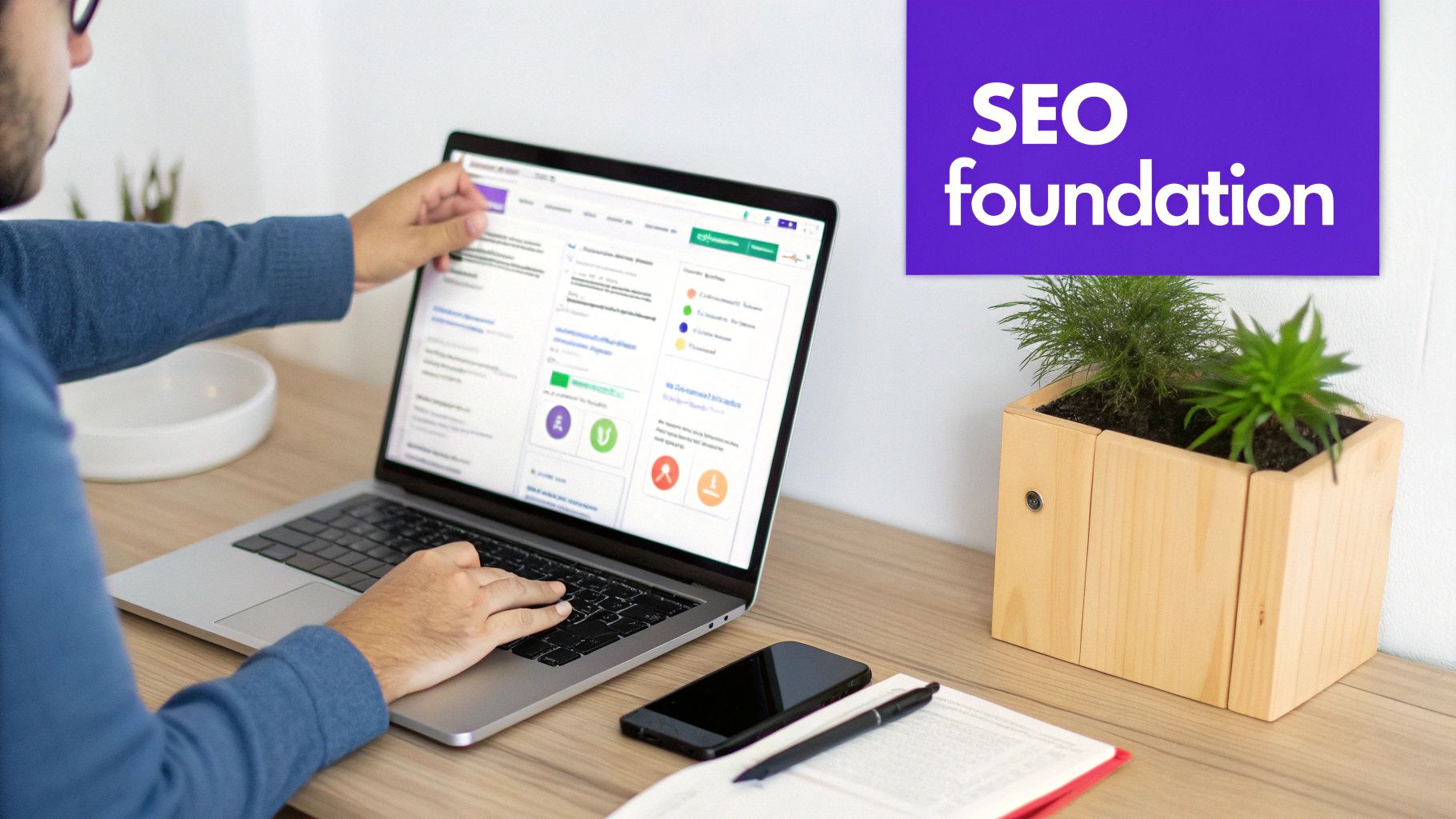When it comes to SEO, everything boils down to two things: making sure search engines can technically understand your website, and creating genuinely useful content that people actually want to read. Get both right, and you’ve built a powerful engine for attracting qualified leads. In fact, companies that prioritize SEO are 13 times more likely to see positive ROI. It’s that simple.
Build a Rock-Solid SEO Foundation

Before you can even dream of ranking for competitive keywords, your website needs to be technically flawless. Too many B2B startups jump straight into blogging, only to find their efforts wasted because the site is slow, confusing for search engines, or broken on mobile.
Think of it like building a house. You wouldn't put up the walls before pouring a solid concrete foundation. A technically sound website is the bedrock for everything else you do in SEO. It ensures Google’s crawlers can find, understand, and index your content without hitting dead ends.
The Real-World Impact of Technical SEO
Neglecting your site’s technical health has very real consequences. A website that takes more than three seconds to load can lose nearly 40% of its visitors before they even see your homepage. That's not just a lost click; it's a lost lead. And you can bet Google is paying attention—page speed is a confirmed ranking factor.
I once worked with a B2B software company that saw a 50% jump in organic traffic in just three months. Their secret wasn't some viral blog post. It was a meticulous technical audit that fixed hundreds of broken internal links and shaved two seconds off their mobile load time. These "boring" fixes translated directly into higher rankings and more demo requests. This is how you build an SEO strategy from the ground up, making every piece of content you create later exponentially more powerful.
Your Quick-Win Technical Audit Checklist
A full technical audit can feel overwhelming, so let's start with a few high-impact areas. These are the quick wins that deliver immediate value and set the stage for more advanced work down the road.
Your first stop should be Google Search Console. It’s your direct line to Google and will flag many of these issues for you, for free.
- Page Speed: Check your Core Web Vitals report. Focus on improving your Largest Contentful Paint (LCP) by compressing images and using browser caching. A success story from Deloitte showed that a mere 0.1-second improvement in site speed boosted conversions by 8.4%.
- Mobile Usability: Over 60% of B2B buyers research purchases on their phones. Your site has to be perfect on mobile. The "Mobile Usability" report in Search Console will show you exactly which pages have errors like tiny text or buttons that are too close together.
- Crawl Errors: Head over to the "Coverage" report to find pages Google can’t access (404 errors) or is having trouble indexing. Fixing broken internal links is one of the easiest yet most powerful ways to improve both crawlability and user experience.
Key Takeaway: A technically healthy website isn’t a "nice-to-have"—it's a non-negotiable prerequisite for ranking. By tackling core issues like site speed and mobile-friendliness, you're signaling to search engines that your site provides a quality experience worthy of a top spot.
Fixing these foundational problems ensures that when you do invest in creating great content, it actually has a chance to be seen. You can dive deeper into the specifics in our complete guide on SEO for B2B websites.
A solid technical base ensures that search engines can properly reward your future efforts in content and link building. Ready to turn these insights into action and build a foundation that competitors can't shake?
Contact our team today for a personalized SEO consultation and let us build your roadmap to sustainable growth.
Create Content That Captures High-Intent Leads

With your technical SEO foundation sorted, it's time to get down to the real work: creating content that wins over high-value B2B customers. This isn't about the mechanics anymore. It’s about answering your ideal customer's toughest questions and solving their most complex problems.
Forget churning out generic blog posts. The goal is a focused strategy that captures high-intent leads—the prospects who aren’t just browsing but are actively looking for a solution like yours. By understanding exactly what they’re typing into Google, you can position your brand as the answer they’ve been searching for.
Understanding B2B Search Intent
The secret to effective content is getting a grip on search intent—the “why” behind what someone searches for. In the B2B world, intent usually falls into a few key buckets that map directly to the buyer's journey.
- Informational Intent: Your prospect is in research mode, looking for answers and education. They might be searching for things like "benefits of marketing automation" or "how to calculate customer acquisition cost." This is your cue to create comprehensive, expert guides that teach them something valuable.
- Commercial Intent: They're a bit further down the path, now comparing different solutions. Their searches start to look like "Salesforce vs HubSpot" or "best project management software for startups." Detailed comparison guides, alternatives pages, and case studies are your best friends here.
- Transactional Intent: Decision time. They're now looking for product pages, pricing, or a demo. Your core service and solution pages need to be perfectly optimized to capture this final-stage interest.
By aligning your content with these different stages, you create a seamless path from awareness to purchase. You stop being just another vendor and become their trusted guide instead.
Crafting Authoritative Long-Form Content
In B2B, surface-level content just doesn't fly. Your audience is sharp and they’re looking for deep expertise. This is where authoritative, long-form content becomes one of your most powerful tools for building trust and improving SEO.
Investing in high-quality, long-form content is a proven winner. Research consistently shows that articles over 3,000 words can pull in three times more traffic, get four times more shares, and earn 3.5 times more backlinks than average-length posts.
We saw this firsthand with a B2B cybersecurity client struggling to rank for competitive terms. We helped them develop a 4,000-word pillar page on "small business network security" that covered everything from common threats to implementation frameworks. Six months later, it was sitting on page one and generating a steady flow of qualified leads for their consulting services. It's not a one-off thing, either. The best content builds momentum over time.
On-Page Optimization That Works
Creating great content is only half the battle. You also need to optimize it so that search engines can understand its value and show it to the right people. This comes down to a few key on-page SEO elements that work together to signal relevance and quality.
Optimizing Your Key Page Elements
- Title Tags: This is your page's headline in the search results. It has to be compelling and include your primary keyword. Instead of something generic like "Our Services," a title like "Fractional CMO Services for B2B Tech Startups" is far more effective.
- Meta Descriptions: While not a direct ranking factor, a well-written meta description is your ad copy. It needs to entice users to click by summarizing the page's value and including a clear call to action.
- Headings (H1, H2, H3): Use headings to give your content a logical structure. Your main title should always be an H1, with subtopics organized under H2s and H3s. This makes the page easier for people to read and helps search engines understand the hierarchy of your information.
- Internal Linking: Link strategically to other relevant pages on your site. This helps spread authority around your website and guides users toward more valuable content, keeping them engaged for longer. For a deeper look, check out our guide on B2B website content optimization to boost your online presence.
Mastering both content creation and on-page optimization turns your website from a static brochure into a lead-generation machine that attracts qualified prospects who are already looking for what you offer. Feeling overwhelmed by the content treadmill? Contact us to build a content strategy that drives real results.
Earn Authority with Strategic Link Building
You can have the most brilliant content on a technically flawless website, but without authority, it won't rank. The secret ingredient? Backlinks.
Think of backlinks from other respected websites as votes of confidence. The more high-quality votes you collect, the more Google sees your site as a credible, authoritative source—and rewards you with higher rankings. This is the heart of link building, and for B2B companies, it's not about spammy tactics or buying links. It’s about earning trust.
Move Beyond Outdated Tactics
In the old days, link building meant sketchy schemes like endless directory submissions and comment spam. Not only do these tactics no longer work, but they can also actively damage your rankings.
Today, it's all about quality over quantity. A single backlink from a major industry publication is worth far more than a hundred links from low-quality, irrelevant blogs. The goal is to build a backlink profile that looks natural and is built on genuine relationships and truly valuable content.
How to Earn High-Quality Backlinks
Earning powerful backlinks requires a proactive, strategic approach. It’s about creating assets that make other sites want to link to you. Here are three methods that work exceptionally well for B2B startups and scale-ups.
Create Original, Data-Driven Research
Journalists, bloggers, and industry experts are always hunting for fresh data to support their content. When you conduct your own research—like a survey of your customers or an analysis of industry trends—you create a unique, linkable asset.
For example, a B2B SaaS client of ours released a single, data-driven report on remote work productivity. It was packed with original statistics and insightful charts. The result? They landed backlinks from three major tech publications, which helped boost their organic traffic by 40% in just six months.
Leverage Guest Posting on Industry Blogs
Writing for other respected publications in your niche is a classic win-win. You provide them with expert content, and in return, you get a valuable backlink and exposure to their audience. The key is to focus on blogs that your ideal customers actually read.
Pitch genuinely helpful, non-promotional article ideas. Your goal here isn't to advertise your product; it's to share your expertise. The authority you build is far more valuable than a direct sales pitch. For instance, Buffer famously grew to its first 100,000 users almost entirely through guest posting on high-authority sites.
Participate in Expert Roundups and Interviews
Many publications create "expert roundup" articles where they gather quotes from multiple industry leaders on a specific topic. Getting included is a fantastic way to earn a high-quality link and position yourself as a thought leader. Use platforms that connect journalists with sources to find these opportunities.
Key Insight: Strategic link building is really an act of content promotion. You're not just building links; you're building relationships and showcasing your expertise where your target audience already spends their time.
The Local Angle for Broader Authority
While earning links from national publications is a huge win, don't overlook local opportunities, especially if you serve specific geographic markets. With 46% of all Google searches having local intent, optimizing for your region is a must, even for B2B.
Engaging with local business journals or industry groups can help build a well-rounded and trustworthy backlink profile. You can find more SEO statistics and see how local search trends are shaping digital marketing on NealSchaffer.com.
By combining broad, authority-building content with targeted local engagement, you create a powerful link-building strategy that drives results from all angles.
Ready to build a backlink profile that commands authority and drives real growth? Contact us to develop a strategic link-building campaign that gets you noticed.
Your 90-Day B2B SEO Action Plan
Knowing what to do in SEO is one thing. Knowing the right order to do it in is what separates the campaigns that fly from the ones that flop. A structured plan takes those big, abstract goals and breaks them down into a manageable process that builds real momentum.
I've designed this 90-day roadmap specifically for B2B startups and scale-ups. It prioritizes the actions that deliver both quick wins and long-term value, making sure you’re always focused on what moves the needle.
Days 1-30: Foundational Fixes and Quick Wins
The first month is all about laying a solid groundwork. Your top priority is to hunt down and fix the technical gremlins that can sabotage even the most brilliant content. Think of it as clearing the runway before takeoff.
Your main goal here is to knock out a full technical audit and squash any critical errors. This isn't optional for anyone serious about SEO.
- Fix Crawl Errors: Dive into Google Search Console's "Coverage" report to find and fix 404s and redirect chains. A clean, accessible site is one that search engines can easily understand and index.
- Optimize Core Pages: Sharpen the title tags, meta descriptions, and on-page content for your most important service and solution pages. Make sure they’re laser-focused on your main commercial keywords.
- Boost Site Speed: Tackle Core Web Vitals issues, focusing on low-hanging fruit like image compression and enabling browser caching. Even a one-second improvement in load time can lift conversions by 7%.
By the end of this phase, you should see a big jump in your site’s technical health score and have your crawl errors down to nearly zero. This sets the stage for your content to actually get seen and ranked.
Days 31-60: Content Momentum and Optimization
With your technical house in order, month two is all about creating and refining the content that will pull in your ideal audience. This is where you start building topical authority and answering the burning questions your prospects are typing into Google.
The objective is to establish a consistent publishing rhythm and begin optimizing your existing content for better performance. A huge piece of this is aligning content with search intent. For instance, businesses that tailor content to transactional intent see up to 30% more conversions than those with generic material.
This timeline breaks down the core activities for promoting new content and earning those crucial backlinks.

As the infographic shows, getting quality links is a process. It often starts with targeted guest posting and deep research before you can scale up to broader outreach like expert roundups.
Days 61-90: Promotion and Performance Measurement
The final stretch of your initial 90-day sprint is all about promotion and analysis. Great content won't promote itself. You need a proactive strategy to get it in front of the right eyeballs and earn authoritative backlinks.
This is also when you lock in your measurement framework to track progress and prove the ROI. After all, you can't improve what you don't measure. For a deeper dive, check out our complete guide on SEO strategy and tactics for 2024.
Here are your key actions for this period:
- Launch Your First Outreach Campaign: Start promoting your best pillar content to relevant industry blogs and publications to secure guest posting and backlink opportunities.
- Establish Your Measurement Framework: Set up a dashboard in Google Analytics 4 to track the metrics that matter: organic traffic, keyword rankings for your target terms, and lead conversions from search.
- Conduct a Content Gap Analysis: Use an SEO tool to find the keywords your competitors are ranking for that you aren’t. This data is gold for planning your next quarter's content calendar.
To help you stay on track, I've put the entire roadmap into a simple table. It’s a great way to visualize the flow and keep your team aligned.
The B2B SEO 90-Day Action Plan
| Timeframe | Primary Focus | Key Actions | Success Metric |
|---|---|---|---|
| Days 1-30 | Foundational & Technical SEO | Complete technical audit, fix crawl errors, optimize core page titles & metas, improve site speed. | Technical health score >90%, crawl errors near zero. |
| Days 31-60 | Content Creation & Optimization | Publish new pillar & cluster content, update existing assets, conduct keyword research for new topics. | 2-3 new high-quality articles published, keyword rankings improve. |
| Days 61-90 | Promotion & Measurement | Launch first link-building campaign, set up analytics dashboard, conduct content gap analysis. | 3-5 new high-quality backlinks, organic traffic growth of 5-10%. |
Following this structured plan gives you a clear path to building a powerful B2B SEO engine. It’s about making steady, deliberate progress every single month. Ready to get started? Contact us to put your 90-day plan into action.
Measure What Matters with the Right SEO Tools

You can't improve what you don't measure. A successful SEO program isn't built on guesswork; it’s driven by data that shows you what’s working, what isn’t, and where your next big opportunity lies.
Tracking performance is how you demonstrate the real business value of your efforts and make smarter decisions to accelerate growth. Without clear metrics, you're flying blind. You might be creating content and building links, but you won't know if those actions are actually translating into more organic traffic, qualified leads, and new revenue.
This is where the right set of SEO tools becomes essential, turning abstract goals into tangible results.
Demystifying Your Core SEO Metrics
For any B2B startup, the journey into SEO analytics begins with two indispensable free platforms: Google Search Console (GSC) and Google Analytics 4 (GA4). These tools are your direct line to understanding how search engines and users interact with your website.
GSC tells you what happens before a user clicks on your site. It reveals the keywords you’re ranking for, your average position, and your click-through rate (CTR). In a recent campaign for a SaaS client, we saw their impressions for target keywords double in 60 days, which led to a 35% increase in organic clicks.
GA4, on the other hand, shows you what happens after the click. It tracks organic traffic volume, user engagement, and most importantly, conversions. Setting up conversion goals—like demo requests or resource downloads—is how you connect SEO activity directly to business outcomes.
Key Takeaway: Your goal is not just to increase traffic but to increase qualified traffic. By tracking conversions in GA4, you can prove that your SEO strategy isn't just an expense; it's a revenue-generating investment.
Building Your B2B SEO Tech Stack
While the Google suite is foundational, scaling your efforts requires more powerful tools for competitor analysis and backlink tracking. Premium platforms provide the deep competitive intelligence needed to outmanoeuvre others in your industry.
Here’s a look at a typical tech stack, from budget-friendly essentials to advanced platforms:
-
For Startups (Free/Low-Cost):
- Google Search Console: Essential for monitoring keyword performance and technical health.
- Google Analytics 4: The go-to for tracking traffic, user behaviour, and conversions.
- Ahrefs Webmaster Tools: A free version of a premium tool that offers site audits and backlink data.
-
For Scale-Ups (Premium):
- Ahrefs or Semrush: These all-in-one platforms are the industry standard for keyword research, competitor analysis, rank tracking, and in-depth backlink audits. Companies using these tools report being 50% more effective at identifying ranking opportunities.
- Screaming Frog: A powerful desktop crawler for performing deep technical SEO audits on your own site or a competitor's.
By arming yourself with the right tools, you gain a clear, data-backed view of your performance. You can spot opportunities your competitors have missed, diagnose technical issues before they become major problems, and confidently report on the progress you're making.
If you want to accelerate your growth and ensure your SEO strategy is executed flawlessly with the best tools in the industry, our team is here to help.
Contact us today for a personalized consultation, and let our expertise drive your business forward.
Frequently Asked Questions About B2B SEO
Let's clear the air. When it comes to improving SEO, B2B marketers tend to ask the same handful of questions. Here are some straight answers to the most common ones.
How Long Does It Take to See SEO Results?
Ah, the classic "it depends" question. But you need a realistic timeline, so let's get specific. You can often see some early movement from quick wins—like fixing crawl errors or sharpening up your title tags—within the first 30 to 90 days.
However, for the more competitive keywords that actually drive qualified traffic and leads, you should be thinking in terms of 6 to 12 months. That's the timeframe needed to build enough authority and relevance to see significant, lasting results. SEO is a long-term investment, not an overnight fix; a solid strategy builds momentum month after month.
What Is a Good Starting SEO Budget for a B2B Startup?
Your budget will always depend on how competitive your industry is and your own growth targets. But for a B2B startup or scale-up looking to make real progress, a reasonable starting point typically falls between $3,000 and $7,000 per month.
What does that investment usually cover?
- A proper technical SEO audit and ongoing monitoring.
- Strategic keyword research and a solid content plan.
- The creation of high-quality, authoritative blog posts and landing pages.
- Initial link-building and content promotion to get the ball rolling.
Even a smaller budget can make an impact if you focus on one key area at a time—nailing your technical SEO first, for example, or creating a few incredibly high-value content pieces. The real key is consistency.
Which SEO Metrics Matter Most?
It’s incredibly easy to get lost in a sea of data. For B2B companies, the only metrics that really matter are the ones that tie directly to business growth. While tracking keyword rankings is a decent pulse check, the numbers that truly move the needle are:
- Organic Traffic Growth: A steady increase in non-paid visitors from search engines. This is your foundational health metric.
- Keyword Impressions & Clicks: You’ll find this in Google Search Console. It’s proof that your visibility is growing for the terms that matter.
- Lead Conversions from Organic Search: This is the ultimate proof of ROI. How many demo requests, form fills, or gated content downloads are coming directly from your SEO efforts? Companies that nail their SEO often generate over 50% of their leads this way.
- Backlink Acquisition: Tracking the number of new, high-quality backlinks you earn is a key indicator of your site's growing authority in your niche.
These metrics give you a clear, no-fluff picture of how your SEO improvements are directly contributing to your pipeline and, ultimately, your revenue.
Ready to stop guessing and start growing? The team at B2Better has over 45 years of combined experience helping B2B companies build SEO programs that deliver measurable results. Let us build a clear strategy to drive your growth. Contact us for a personalized consultation today.
- Written by: B2Better
- Posted on: November 11, 2025
- Tags: b2b seo strategy, content marketing seo, how to improve seo, link building, technical seo audit

